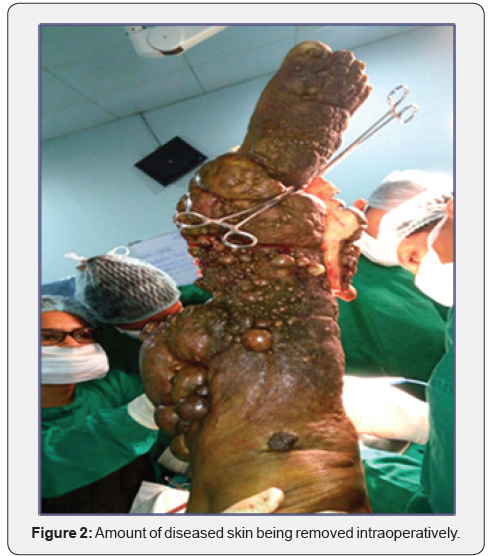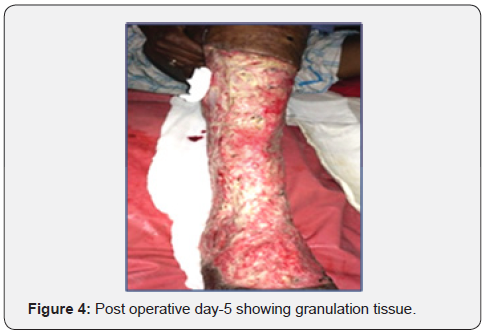Debulking Surgery- An Effective Line of Management to Prevent Morbidity in Elephantiasis Leg
Gaurav Gupta1, Khairul Enam1, Swapnil Deshpande1, Sangeeta Gupta2*, JN Agrawal3, Babita Agrawal3 and Vaishali Bhagat1
1Department of Surgery, Shri Shankaracharya Institute of Medical Sciences, India
2Department of Physiology, Shri Shankaracharya Institute of Medical Sciences, India
3Department of Anaesthesia, Shri Shankaracharya Institute of Medical Sciences, India
Submission: January 13, 2018; Published: February 22, 2018
*Corresponding author: Sangeeta Gupta, Professor, Department of Physiology, Shri Shankaracharya Institute of Medical Sciences, Bhilai, Chhattisgarh, Pin code: 490020, Tel: +91- 7015043682; Email: drsangeeta77.65@rediffmail.com
How to cite this article: Gaurav Gupta, Khairul Enam, Swapnil Deshpande, Sangeeta Gupta, et al. Debulking Surgery- An Effective Line of Management to Prevent Morbidity in Elephantiasis Leg. Anatomy Physiol Biochem Int J: 2018; 4(3): 555636. DOI: 10.19080/APBIJ.2018.04.555636.
Abstract
Background: Elephantiasis leg is a gross disfigurement of the limb due to advanced stages of lymphoedema resulting in disabling and distressing conditions. Conservative therapies are less effective at this stage and reduction in the volume and prevention of the risks of soft tissue functions hold greater concern.
Methods: We present a case of an advanced case of lymphoedema of right lower limb in a 55 year-old male. Clinical examination and investigations confirmed it as a case of elephantiasis leg with gross disfigurement. After reductions of oedema and control of infections, reduction surgery was performed and massive amount of thickened skin was removed. Skin grafting will be planned after the appearance of healthy granulation tissue.
Conclusion: Advanced stages of lymphoedema necessitate reduction/debulking surgery to alleviate the extreme disability in elephantiasis leg. The debulking surgery performed in specialized centers with appropriate post-operative care can reduce the morbidity of the condition to a great extent.
Introduction
Elephantiasis is a condition where chronic lymphoedema progresses to dermatosclerosis, deep skin folds and papillomatous lesions and is one of the extreme forms of clinical manifestation of lymphatic filariasis caused by parasitic worms of the roundworm family. The parasites lodge in the lymphatic system leading to chronic obstruction and subsequent oedema. Lymphoedema, hydrocele, Lymph scrotum, chyluria etc can be various other clinical manifestations of lymphatic filariasis [1]. The term elephantiasis particularly represents the large disfigured state of the limb caused by lymphoedema, often as a result of the parasitic infestation. It is stated to be the second leading cause of long term disability and socioeconomic consequences in the world, causing severe disabilities and socioeconomic problems over the course of a life time [2]. Disability alleviation is necessitated, particularly in these patients with advanced lymphoedema states, to reduce the morbidity of this condition.
Case Report
A 55-year-old male patient presented with gradually progressive swelling in the right leg since 15 years. It was difficult for the patient to carry on with his occupation (as a gatekeeper) when he developed pain and ulcerations in the massive swelling since 4-5 months. He also had fever off and on since past few weeks. Clinical appearance was of advanced case of lymphedema due to microfilaria (commonly called as Elephantiasis) which is endemic in this part of the country [3,4]. Investigations were performed in the patient (Figure 1). TLC (total leucocyte count) was found to be raised; peripheral smear confirmed it to be a case of filariasis. As the patient had multiple ulcers and lymphorrhea he was started on antibiotics and DEC (Diethyl Carbamazine). Limb elevation and compression was also given to reduce the edema.

Reduction surgery was planned after a week with the arrangement of adequate blood transfusions. During surgery it was found that there was no normal skin which could be left behind, the whole skin of the leg below the knee up to dorsum of the foot was markedly thickened fibrosed and at few areas calcified, hence circumferentially whole skin had to be removed (Figure 2). Tourniquet was used during the surgery but on releasing it blood pressure fell down to 70mmHg for few minutes which was managed by the anesthesia team by giving fluids and blood transfusion till the haemostasis was achieved by the surgical team. Massive amount of thickened skin was removed which weighed about 9.7kg. Postoperatively patient is doing well and skin grafting would be planned after healthy granulation tissue is achieved (Figures 3 & 4).



Discussion
Elephantiasis characterizes a disfiguring end-stage of lymphatic disease (stage III according to the International Society of Lymphology) with profound but circumscribed changes in soft tissue [5]. Tissue fibrosis, fat deposition, hyperpigmentation, cutaneous acanthosis, and papillomatosis are present. The skin develops a cobble-stone surface pattern. The disease is slowly progressive. An increased risk of soft tissue infections can further aggravate the condition. Debulking surgery is an option for these patients where it intends to reduce the distressing volume as well as can prevent the soft tissue infections [6,7]. Elephantiasis is an end-stage lymphatic disease, where DLT (Decongestive lymphatic therapy) is necessary to control the disease but seldom results in significant improvement [6]. Compression bandage support, regular exercise and elevation of the limb at night are suggested in the individuals with chronic lymphatic filariasis. Although large hydroceles and scrotal elephantiasis can be managed with surgical excision, correcting gross limb elephantiasis with surgery has been reported to be less successful and often involves multiple procedures and skin grafting [8].
Liposuction is also of limited value in this condition due to tissue fibrosis. Debulking surgery, albeit has been suggested in cases with severe impairment and in those not responding to conservative or minimally invasive surgical procedures, to improve the quality of life [7,9,10]. This procedure has to be used as an adjunct to DLT (decongestive lymphatic therapy) and should be considered for patients who fulfil the following criteria: end-stage chronic lymphedema accompanied by increased difficulty in providing effective DLT (highly disfigured extremity) and increased frequency of soft tissue infections [11]. Surgery for lymphedema has been advocated to reduce the weight of the lymphedematous region, minimize the frequency of infectious/ inflammatory episodes, and/or improve cosmesis and function. Several categories of surgical treatment have been proposed for the treatment of lymphedema.
1. Excisional operations (e.g. debulking, amputation and liposuction),
2. Lymphatic reconstruction and
3. Tissue transfer procedures (e.g. lymph node transplantation, pedicled omentum, bone marrow stromal cell transplantation).
While Lymphatic reconstruction and tissue transfer procedures can be done in earlier stages of Elephantiasis, debulking procedures and split skin grafting have been employed for late stages of elephantiasis. Several approaches for debulking surgery have been developed. Excision of large amounts of subcutaneous tissue with insufficient lymphatics followed by adaption to muscle aponeurosis and/or muscular tissue after partial removal of aponeurosis has been performed for a long time. The idea behind this technique was de novo formation of lymphatics and blood vessels from sprouting of intramuscular blood and lymphatic vessels [7,9]. In our case also, debulking of the diseased skin of the whole leg from just below knee to dorsum of foot has been done. However, for longterm success of excisional surgery, postoperative complications and maintenance of DLT become a major critical issue.
Conclusion
Surgical management in elephantiasis in the form of debulking surgery is a suitable option for the patients with end-stage chronic lymphedema accompanied by increased difficulty in providing effective DLT (in highly disfigured extremity). Postoperative complications may occur, but they are usually manageable. Patients can live a better quality of life. Nevertheless, debulking surgery is an adjunctive treatment to decongestive lymphatic therapy and should be performed with caution by experienced surgeons in specialized centers.
Conflict of Interest
None.
References
- Dreyer G, Dreyer P, Piessens WF (1999) Extralymphatic disease due to bancroftian filariasis. Braz J Med Biol Res 32(12): 1467-1472.
- World Health Organization (2013) Lymphatic Filariasis Managing Morbidity And Preventing Disability. World Health Organization Geneva, Switzerland.
- Regu K, Rajendran R, Ali MK, Koya SM, Dhariwal AC, et al. (2005) Decline of brugian filariasis in Cherthala taluk, Alappuzha district, Kerala. J Commun Dis 37(3): 209-218
- National Vector Borne Disease Control Programme, Directorate General of Health Services, Ministry of Health and Family Welfare, Government of India. Delhi, India.
- International Society of Lymphology (2009) The Diagnosis and Treatment of Peripheral Lymphedema. Consensus Document of the International Society of Lymphology. Lymphology 36(2): 84-91.
- International Society of Lymphology (2013) The diagnosis and treatment of peripheral lymphedema: 2013 Consensus Document of the International Society of Lymphology. Lymphology 46(1): 1-11.
- Kim DI, Lee BB, Huh S, Lee SJ, Hwang JH, et al. (1998) Excision of subcutaneous tissue and deep muscle fascia for advanced lymphedema. Lymphology 31(4): 190-194.
- Andrzej Szuba, Stanley G Rockson (1998) Lymphedema: classification, diagnosis and therapy Vascular Medicine 3(2): 145-156.
- Heinig B, Wollina U (2003) Surgery in congenital lymphedema: a follow-up of 50 years. Int J Low Extrem Wounds 2(3): 173-176.
- Wang HD, Shridharani SM, Tufaro AP (2013) The basic principle is the excision of affected cutaneous and subcutaneous tissue-dermatofibro- lipectomy Lymphedema. Eplasty 13: 24.
- Uwe Wollina, Birgit Heinig, Jaqueline Schönlebe and Andreas Nowak (2014) Debulking Surgery for Elephantiasis Nostras With Large Ectatic Podoplanin-Negative Lymphatic Vessels in Patients With Lipo- Lymphedema. Eplasty 14: e11.






























